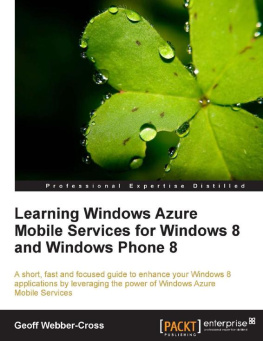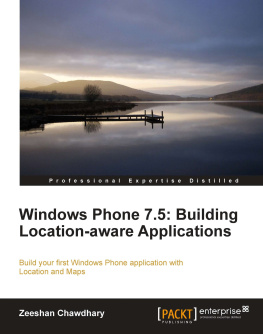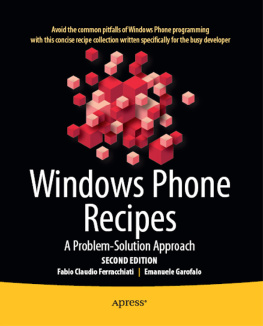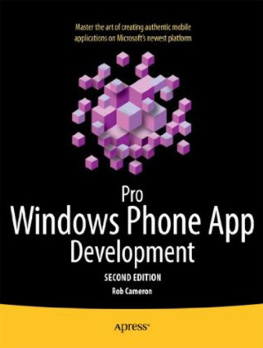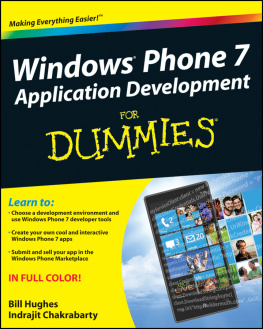Windows Phone 7 Developer Guide: Building connected mobile applications with Microsoft Silverlight
Dominic Betts
Federico Boerr
Scott Densmore
Jose Gallardo Salazar
Alex Homer
Copyright 2011
Information in this document is subject to change without notice. The names of companies, products, people, characters, and/or data mentioned herein are fictitious and are in no way intended to represent any real individual, company, product, or event, unless otherwise noted. Complying with all applicable copyright laws is the responsibility of the user. No part of this document may be reproduced or transmitted in any form or by any means, electronic or mechanical, for any purpose, without the express written permission of Microsoft Corporation. If, however, your only means of access is electronic, permission to print one copy is hereby granted.
Microsoft may have patents, patent applications, trademarks, copyrights, or other intellectual property rights covering subject matter in this document. Except as expressly provided in any written license agreement from Microsoft, the furnishing of this document does not give you any license to these patents, trademarks, copyrights, or other intellectual property.
All rights reserved
Microsoft, Windows, Windows Azure, Windows Live, Windows Vista, ActiveSync, Bing, Direct3D, DirectX, Excel, Expression Blend, Internet Explorer, MSDN, SharePoint, Silverlight, SQL Azure, Visual Basic, Visual C++, Visual C#, Visual Studio, Xbox, Xbox 360, XNA, and Zune are registered trademarks or trademarks of Microsoft Corporation in the United States and other countries.
Other product and company names herein may be trademarks of their respective owners.
Microsoft Press
Foreword
Great achievements dont happen overnightthey evolve over time based on a series of successes that converge and drive you onward. My favorite soccer team, Seattle Sounders FC, started life way back in 1974 in the North American Soccer League and only achieved their recent success in Major League Soccer through working hard to raise their game and improve their results.
Here at Microsoft, weve always focused on raising our game. In my 20 years with the company, Ive worked on projects ranging from the Microsoft Windows 2.0 SDK and COM, to Windows Media Center and Windows Home Server. Each new generation of products raises the game for both users and developers. And now Im proud to be part of the team thats driving our latest achievement, Windows Phone 7.
Windows Phone 7 is a different kind of phone, designed for life in motion. Its a change from the past that incorporates smart design and is aimed at users who need to manage their personal and business lives as an integrated experience. Or, to be more accurate, a series of integrated experiences that include People, Office, Pictures, Music and Videos, Windows Market Place, and Games.
When designing Windows Phone 7, we stepped back and thought hard about who our customers are and what they need from a phone. Everyone on the Windows Phone 7 team woke up every morning thinking What can I do today to make the end-user experience great? This was true of even the people focused on building the developer experience. The end user always came first; our mantra was Enable end users to personalize their phone experience with great applications and games and ensure that developers can be profitable. It has been extremely gratifying to see the incredible innovation being brought forward by third-party developers building Windows Phone 7 applications and games.
Based on our experience building the Xbox 360, Windows Media Center, and Zune, we built a phone that users can personalize and make their own, that helps developers be profitable, and that enables cloud-powered experiences that align with the Microsoft vision for three screens and the cloud computing.
This book, with its practical scenario-based approach, will help you to be part of that vision. It will guide you through the process of understanding Windows Phone 7, getting started developing applications for the phone, and creating beautiful and engaging user experiences that achieve success in this new and exciting marketplace.
The book explores the four main areas of focus: the phone runtime (code that you write to run on the client), services (code that runs on the cloud), tools to help you design and develop your applications, and tools that help you ship and sell your applications. It does all this within the context of a fictional company that is extending its cloud-powered application to the phone.
As a developer, you need to be part of this new world where life happens on the move. Weve made it easy to leverage your existing skills and apply them to the phone. This book will help you raise your game and score in this exciting new market.
Sincerely,
Charlie Kindel
General Manager, Windows Phone 7
Foreword
Microsoft Windows Phone 7 Series represents a major advance in mobile devices. We have created a completely new model that gives users a new class of phone. Everything from the underlying operating system and the application platform, to the delivery, style, and performance of applications has been engineered to provide a great user experience.
Windows Phone 7 is a major part of the Microsoft vision for mobile computing, and a core component in the three screens and the cloud philosophy. It allows users to enjoy an immersive and productive environment, full interaction with other Microsoft platforms and applications, and access to all existing web experiences.
We have made the phone intuitive for users and very familiar for developers writing applications. Developers can reuse their skills, tools, knowledge, and experience to create great mobile applications using the Microsoft .NET Framework, Silverlight, XNA, Visual Studio, and more. These applications and the development environment are consistent across the desktop, the web, the cloud, and mobile devices.
This guide is a great starting point for your journey through Windows Phone 7 development. It provides a pragmatic, actionable approach to planning, designing, and building applications that can reach out into the cloud and take advantage of the power and capabilities available there for both business users and consumers.
In this guide, you will see how easy it is to build applications that work well for life on the move, provide a compelling and integrated experience for users, and allow you to create a revenue source. We have worked very hard to make Windows Phone 7 an indispensible part of the users lifestyle, and this guide will help you to play your part in this exciting new mobile world.
Sincerely,
Istvan Cseri
Distinguished Engineer, Windows Phone
Preface
Windows Phone 7 provides an exciting new opportunity for companies and developers to build applications that travel with users, are interactive and attractive, and are available whenever and wherever users want to work with them.
By combining Windows Phone 7 applications with on-premises services and applications, or remote services and applications that run in the cloud (such as those using the Windows Azure technology platform), developers can create highly scalable, reliable, and powerful applications that extend the functionality beyond the traditional desktop or laptop; and into a truly portable and much more accessible environment.
This book describes a scenario around a fictitious company named Tailspin that has decided to encompass Windows Phone 7 as a client device for their existing cloud-based application. Their Windows Azure-based application named Surveys is described in detail in a previous book in this series,


